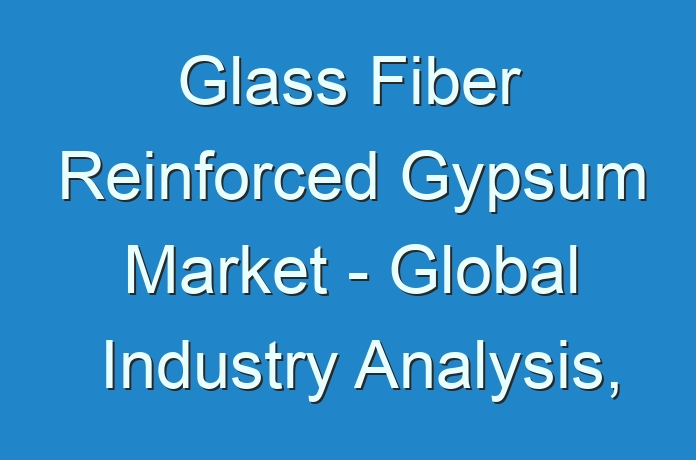
Global Glass Fiber Reinforced Gypsum Market: Overview
Glass fiber reinforced gypsum (GFRG) was invented in England in 1977. It is manufactured by reinforcing high density alpha-based gypsum plaster with glass fibers. The gypsum plaster needs to be low alkalinity and neutral in order to ensure its compatibility with “E” glass fibers. Other additives are also added to the mixture, depending upon the gypsum manufacturer’s recommendations. The resultant product is light, strong, and fire-retardant. It can be molded into many shapes and products. It is also known as fiberglass reinforced gypsum (GFRG) and glass reinforced gypsum (GRG).
GFRG is commonly used in the construction industry. However, it can only be used in applications where it is not subjected to dampness. Applications of GFRG include columns, moldings, ceiling, light coves, medallions, domes, capitals, fire-place surroundings, and custom shapes. Examples of applications where GFRG cannot be used include fountains and pools. GFRG can be considered an architectural material and can be used to enhance the decorative quality of its surroundings. Common construction examples where GFRG is used include residential construction, office construction, and commercial constructions like casinos, hotels, and theaters. GFRG is available in many forms. For example, it can be purchased as panels, pieces, or in powder form. It is estimated that panels are the most-commonly used form of GFRG.
Request a Sample –
https://www.transparencymarketresearch.com/sample/sample.php?flag=S&rep_id=46722
GFRG offers several advantages. The most important advantage of using gypsum is its flame-resistant nature. GFRG is a mineral and does not burn. Additionally, it acts as a thermal regulator when exposed to flame and protects the materials behind it from the heat of the flame for at least some duration of time. Compared to other architectural materials such as traditional stone or plaster, GFRG is relatively lightweight; hence, it can be installed quickly and with relative ease. It can also be cast into virtually any shape, allowing for a high level of detailing. GFRG is available in white color. Therefore, it can be painted into virtually any color required. Thus, GFRG is used not only for the exterior decoration of buildings, but also for interior decoration of these buildings. Applications in both these cases can vary considerably in number and are dependent upon customer requirements.
On the other hand, GFRG also carries certain disadvantages. For instance, its price is steeper due to the relative complexity of the manufacturing process. GFRG also lacks ductility; hence, it is prone to breakage. Its poor weather resistance is also a problem which can potentially lead to GFRG’s higher usage in the interior section of a building, as compared to the exterior section of the building.
GFRG was used for the first time in North America in the late 1970s and immediately gained widespread acceptance. Since then, the use of GFRG has spread across the world. Currently, it is used in all regions of the world, viz. North America, Europe, Latin America, Asia Pacific, and Middle East & Africa.
Request for covid19 impact analysis –
https://www.transparencymarketresearch.com/sample/sample.php?flag=covid19&rep_id=46722
Global Glass Fiber Reinforced Gypsum Market: Key Players
Large numbers of manufacturing companies operate in the global Glass Fiber Reinforced Gypsum market. Key players in Glass Fiber Reinforced Gypsum market are Formglas Products Ltd. (first manufacturer in North America); GC Products Inc.; Plasterform; CertainTeed, American Gypsum, Knauf Danoline, Georgia-Pacific, USG Corporation; and FACT – RCF Building Products Ltd (FRBL).
This study by TMR is all-encompassing framework of the dynamics of the market. It mainly comprises critical assessment of consumers’ or customers’ journeys, current and emerging avenues, and strategic framework to enable CXOs take effective decisions.
Our key underpinning is the 4-Quadrant Framework EIRS that offers detailed visualization of four elements:
- Customer Experience Maps
- Insights and Tools based on data-driven research
- Actionable Results to meet all the business priorities
- Strategic Frameworks to boost the growth journey
The study strives to evaluate the current and future growth prospects, untapped avenues, factors shaping their revenue potential, and demand and consumption patterns in the global market by breaking it into region-wise assessment.
The following regional segments are covered comprehensively:
- North America
- Asia Pacific
- Europe
- Latin America
- The Middle East and Africa
Pre-Book now-
https://www.transparencymarketresearch.com/checkout.php?rep_id=46722<ype=S
Companies in the Glass Fiber Reinforced Gypsum market have increasingly shifted gears with wide application of digital technology across the continuum, from raw material sourcing to manufacturing to generation of final output, to warehousing to final distribution operations. Among the various affects, the market is witnessing new growth economics due to thinning of line between specialty and commodity businesses that are associated with the larger ecosystem. At the same time, new growth parameters are being vigorously being debated as industry stakeholders put greater emphasis on the circular economy processes.
More Trending Report-





